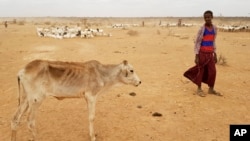Ethiopia is appealing for $1.6 billion to provide emergency and long-term aid for 7.88 million people affected by drought, floods and conflict. U.N. officials presented their humanitarian and disaster resilience plan.
Ethiopia is emerging from three consecutive years of drought in a perilous state. Among those hardest-hit are some 2.4 million pastoralists who have lost 80 percent of their livestock.
U.N. resident and humanitarian coordinator in Ethiopia Ahunna Eziakonwa-Onochie tells VOA herders depend upon the meat and milk from their animals to feed their families.
“So, we are estimating this year that we will see about 3.5 million children who suffer from moderate acute malnutrition and just over 300,000 who have to face severe acute malnutrition," said Eziakonwa-Onochie.
Eziakonwa-Onochie warns children who are severely acutely malnourished are at risk of dying if they do not urgently receive special nutritional feeding.
“Time is of the essence. Unless we are able to catch them early, we end up having more kids crossing into that red zone of severe acute malnutrition," said Eziakonwa-Onochie. "That is what we are absolutely determined to avoid this year. And, that is why we are asking for these resources now because it is totally preventable.”
Other vulnerable people include 1.7 million the United Nations says are displaced by drought and those displaced by conflict in the border areas of the Oromia and Somali regions. They will need to be relocated to areas where there is water so they can restock their animals or pursue other livelihood opportunities.
In parallel with the emergency needs, Eziakonwa-Onochie says the Ethiopian plan aims to build resilience so the nation can better deal with disasters before they strike. For example, she says the government and humanitarian partners are considering digging bore holes in the lowlands. This would make water available for people and their animals when rain is scarce and drought appears on the horizon.






